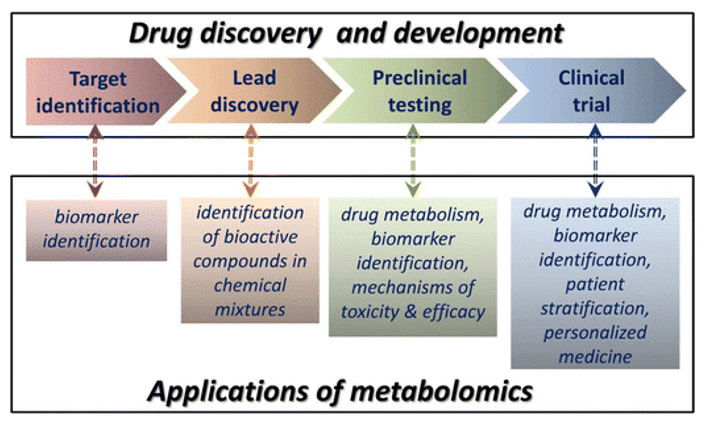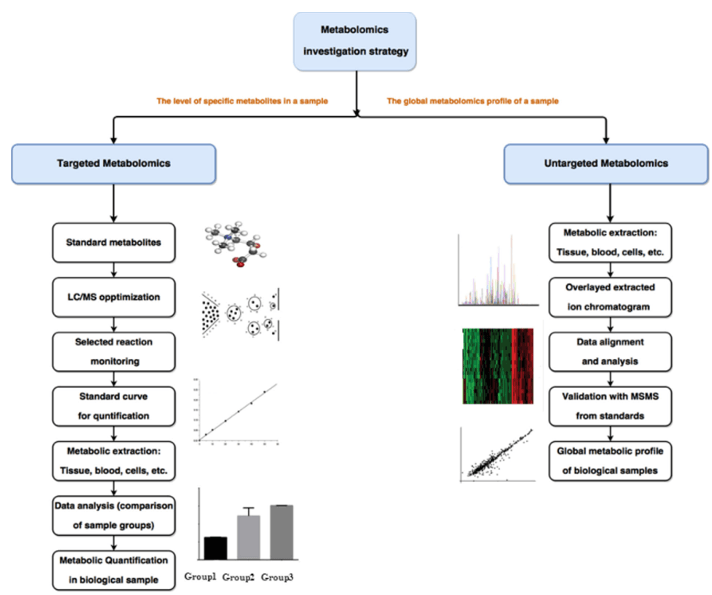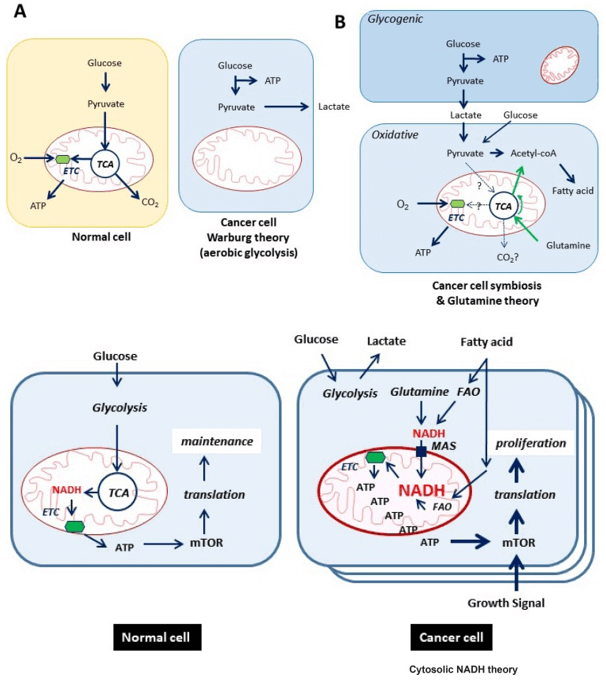What is Lipid Metabolism?
Lipids are hydrophobic or amphipathic small molecules which include fats, waxes, sterols, fat-soluble vitamins (such as vitamins A, D, E and K), monoglycerides, diglycerides and phospholipids. The important roles of lipids in biological physiology are evident not only in energy storage and structural components of cellular membranes, but also in signal transduction, membrane trafficking and morphogenesis. Lipid metabolism is the synthesis and degradation of lipids in cells, consisting of the breakdown or storage of fats for energy and the synthesis of structural and functional lipids like those involved in the construction of cell membranes. The majority of lipids found in animals from ingesting food are triglycerides and cholesterol. Other types of lipids found in the body are fatty acids and membrane lipids. Lipid metabolism analysis is crucial for understanding its role in human health and disease. It provides valuable insights into an individual's health, particularly its involvement in diseases such as cardiovascular disorders, obesity, and diabetes. This analysis is also essential for drug development as pharmaceutical interventions often target lipid-related pathways. In the field of nutritional science, it helps in designing healthier diets by revealing how different lipids affect the body. Moreover, lipid metabolism analysis deepens our understanding of cellular functions, benefiting various areas of biological research. In summary, lipid metabolism analysis is a vital tool with far-reaching implications for health, disease, drug development, and biology.
Advantages of Our Lipid Metabolism Service
Constantly optimized protocol and analytical software
Professional experiment design
Quick turnaround time
High accuracy, specificity, and sensitivity
Workflow of Lipid Metabolism Analysis
1. Consultation and Project Planning:
We begin with a thorough consultation to understand your specific research objectives and requirements. This step is crucial for tailoring the analysis strategy to effectively meet your project's goals.
2. Sample Collection and Preparation:
Our guidance on proper sample collection and preparation ensures that your samples are handled and stored according to the highest standards to maintain sample integrity.
3. Lipid Extraction:
We expertly isolate lipids from your biological samples using advanced extraction methods, resulting in lipid-rich samples for analysis.
4. Separation and Fractionation:
Cutting-edge separation techniques, including HPLC, TLC, and GC, are employed to separate lipid classes based on their physical and chemical properties.
5. Mass Spectrometry and Spectroscopy:
The separated lipid fractions undergo advanced analytical techniques such as LC-MS and GC-MS for quantification and identification analysis.
- Thermo Fisher Q Exactive Series Mass Spectrometers: These instruments are renowned for their high-resolution capabilities, making them ideal for detailed lipid profiling and quantification. The Thermo Fisher Q Exactive series ensures accurate results and robust performance in lipid analysis.
- Agilent Gas Chromatography-Mass Spectrometry (GC-MS): Our Agilent GC-MS systems are instrumental in the precise quantification of fatty acids and other lipid molecules. The exceptional sensitivity and selectivity of these instruments are crucial for lipid analysis.
6. Data Analysis and Interpretation:
Our team of experts performs rigorous data analysis, utilizing specialized software to interpret the results, identify lipid species, and provide in-depth insights into the lipid metabolism of your sample.
7. Customized Reporting:
We deliver comprehensive reports that include detailed findings, graphical representations, and interpretations of the results, ensuring that you have a clear understanding of the outcomes.
Lipid Substances Analyzed at Creative Proteomics
| Lipid Category |
Lipid Substances Analyzed |
| Fatty Acids |
Saturated fatty acids, Monounsaturated fatty acids, Unsaturated fatty acids, Polyunsaturated fatty acids, Omega-3 fatty acids, Omega-6 fatty acids, Trans-fatty acids, Arachidonic acid, Linoleic acid, Alpha-Linolenic acid |
| Triglycerides |
Triglycerides (TAGs), Diacylglycerols (DAGs), Monoglycerides (MGs) |
| Phospholipids |
Phosphatidylcholine (PC), Phosphatidylethanolamine (PE), Phosphatidylserine (PS), Phosphatidylinositol (PI), Phosphatidic acid (PA) |
| Cholesterol |
Cholesterol, Cholesteryl esters, Cholecalciferol (Vitamin D) |
| Sphingolipids |
Sphingomyelin, Ceramides, Sphingosine, Sphingosine-1-phosphate |
| Sterols |
Sitosterol, Campesterol, Stigmasterol, Steroid hormone, Bile acid |
| Glycerolipids |
Glycerolipids, Glycerophospholipids |
| Ether Lipids |
Ether Lipids |
| Lipid Oxidation Products |
Lipid peroxides, Malondialdehyde (MDA), 4-hydroxynonenal (4-HNE), Isoprostanes, Oxysterols |
| Metabolic Pathways |
Fatty acid biosynthesis, Fatty acid elongation, Fatty acid degradation, Ketone bodies |
Applications of Lipid Metabolism Analysis Service
Cardiovascular Health Research: Lipid metabolism analysis is foundational in researching and understanding the factors related to cardiovascular health. It enables comprehensive lipid profiling, aiding in the identification of risk factors for heart diseases and the development of preventive strategies.
Obesity and Diabetes Research: The intricate relationship between lipid metabolism and conditions like obesity and diabetes is a critical focus. Our service sheds light on how lipids are stored, utilized, and modified in these conditions, guiding treatment and prevention strategies.
Drug Development: Pharmaceutical interventions often target lipid-related pathways. Our lipid metabolism analysis is instrumental in drug development, facilitating the identification of potential drug targets and the assessment of lipid-modifying drug efficacy.
Cancer Research: Abnormal lipid metabolism is linked to various cancer types. Our service aids in understanding the role of lipids in cancer progression and the identification of potential therapeutic targets.
Neurodegenerative Diseases: The brain's health relies on lipids, and understanding lipid metabolism is integral to researching neurodegenerative diseases like Alzheimer's and Parkinson's.
Liver Diseases: The liver plays a central role in lipid metabolism. Our service profiles lipid metabolism in the liver, contributing to our understanding of and ability to treat liver diseases.
Cell Biology: Lipids are fundamental components of cell membranes and are involved in various signaling pathways. Our service enhances cell biology research by providing insights into lipid-related mechanisms.
Metabolomics: Lipid metabolism analysis is a crucial component of metabolomics, offering insights into the broader metabolic landscape.
Sample Requirements for Lipid Metabolism Analysis
| Sample Requirements |
Details |
| Sample Type |
Serum, Plasma, Tissue, Cells, Lipid Extracts, etc. |
| Sample Volume |
Minimum 100 µL (for fluids), Minimum 10 mg (for tissues) |
| Sample Storage |
-80°C (frozen) |
| Sample Preparation |
- Homogenize tissues or cells in an appropriate buffer.
- Centrifuge to collect the supernatant. |
| Lipid Extraction |
Follow a validated lipid extraction protocol. |
| Lipid Class of Interest |
Specify the particular lipid classes (e.g., phospholipids, triglycerides) if applicable. |
| Lipid Profiling |
Specify the specific lipid species or molecular species if known. |
| Lipid Quantification |
Report the desired units of measurement (e.g., µmol/L, mg/g tissue). |
| Turnaround Time |
About 3-4 weeks |
| Special Instructions |
- Avoid repeated freeze-thaw cycles.
- Minimize exposure to light for light-sensitive samples. |
Case: Metabolomic Profiling of Hepatocellular Carcinoma (HCC) Plasma Reveals Altered Metabolic Signatures
Background
This research aimed to uncover the metabolic changes in the plasma of patients with intermediate-stage Hepatocellular Carcinoma (HCC) and understand how these changes relate to the disease's pathobiology. The study utilized advanced metabolomic techniques to identify and analyze small molecules in plasma samples.
Samples
The study involved plasma samples from patients with HCC and three control groups: healthy volunteers (HV), patients with liver cirrhosis (LC), and patients with Acute Myelogenous Leukemia (AML). Notably, the AML patients had normal liver function tests, making them suitable controls for liver disease-related metabolic changes.
Techniques
The research employed several techniques for metabolomic analysis. It began with Ultra-Performance Liquid Chromatography-Electrospray Ionization-Quadrupole Time-of-Flight Mass Spectrometry (UPLC-ESI-QTOFMS) to identify and quantify small molecules in the plasma. The data were processed using the random forests machine learning algorithm, which allowed for the differentiation of HCC from the control groups. Additionally, lipid profiling for lysophospholipids (LPCs) was carried out using UPLC-ESI-Triple Quadrupole Mass Spectrometry (UPLC-ESI-TQMS), and profiling of fatty acids was performed using Gas Chromatography-Mass Spectrometry (GC-MS). This comprehensive approach enabled a detailed analysis of the plasma metabolome.
Results
The study yielded several key findings. HCC patients exhibited elevated levels of bile acid conjugates and fetal bile acids in their plasma, indicating alterations in bile acid metabolism. Additionally, bilirubin and biliverdin, two bile pigments, were found to be elevated. The most prominent change was the significant reduction in 11 lysophospholipids (LPCs) in HCC plasma, with the study suggesting that liver cirrhosis played a significant role in this decline. Furthermore, two very long-chain fatty acids, lignoceric acid (24:0) and nervonic acid (24:1), were almost absent in the plasma of HCC and AML patients. Finally, the study identified that LPA(16:0), a product of lysophospholipase D (LPD)/autotaxin (ATX), was elevated in some HCC patients and correlated with alpha-fetoprotein (AFP) concentrations in the plasma, indicating its potential role in hepatocarcinogenesis.
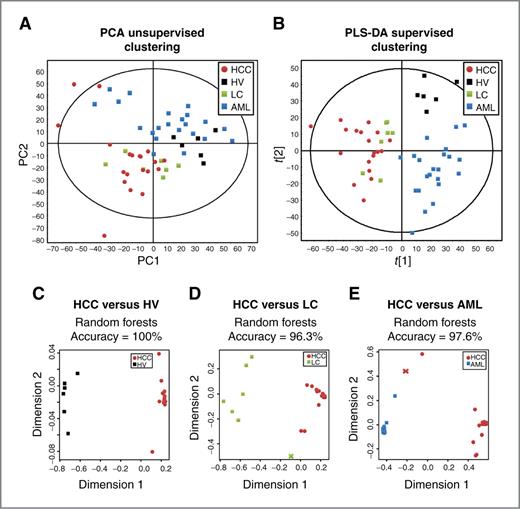 Multivariate data and random forests analyses of ions from HCC plasmas and 3 control groups.
Multivariate data and random forests analyses of ions from HCC plasmas and 3 control groups.
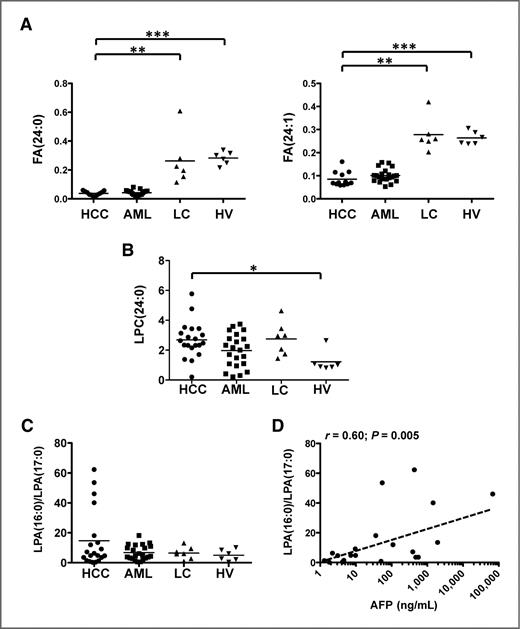 Results of lipid profiling by TQMS and GC-MS for selected fatty acids, LPCs, and LPAs.
Results of lipid profiling by TQMS and GC-MS for selected fatty acids, LPCs, and LPAs.
Reference
- Patterson, Andrew D., et al. "Aberrant lipid metabolism in hepatocellular carcinoma revealed by plasma metabolomics and lipid profiling." Cancer research 71.21 (2011): 6590-6600.


 Multivariate data and random forests analyses of ions from HCC plasmas and 3 control groups.
Multivariate data and random forests analyses of ions from HCC plasmas and 3 control groups. Results of lipid profiling by TQMS and GC-MS for selected fatty acids, LPCs, and LPAs.
Results of lipid profiling by TQMS and GC-MS for selected fatty acids, LPCs, and LPAs.


